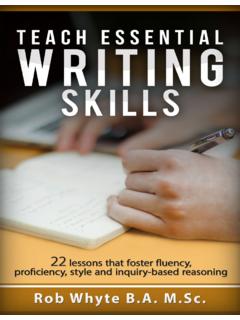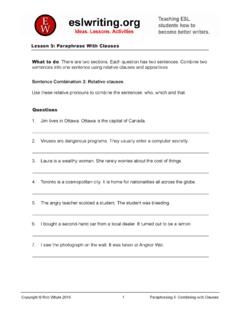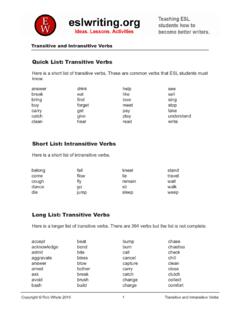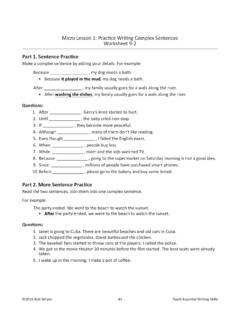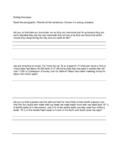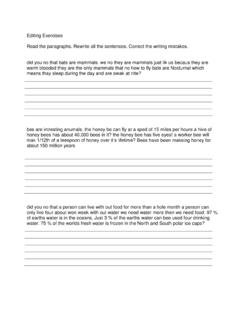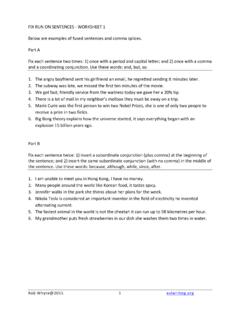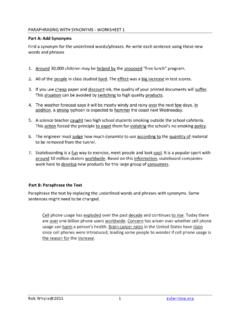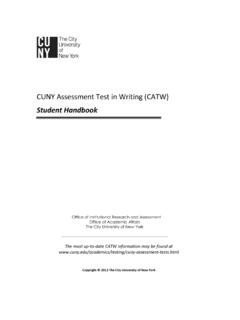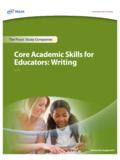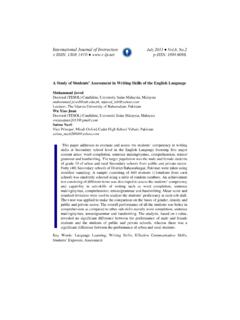Transcription of Teach Essential Writing Skills
1 Teach Essential Writing SkillsCONTENT 04 Introduction09 Fluency and Proficiency10 Before and After11 Timed Repeated Writing13 Timed Sentence Writing16 Parts of Speech20 Basic Articles 27 A Puzzling Story30 Proofreading 33 Appositives41 Complex Sentences 47 More Proofreading50 Style 51 Sentence Fluency 54 More Details 56 Better Paragraphs 59 Basic Cohesion 68 Inquiry-Based Reasoning 69 The Die 71 The Bus 73 The Barber75 Death in the Lobby78 Row Boat Dilemma80 Around the Table83 Email Writing90 Recommend a Phone94 References 2016 Rob Whyte3 Teach Essential Writing SkillsINTRODUCTIONThe principle aim of this ebook is to provide English teachers with classroom resources that help their intermediate level+ students become better writers.
2 I don t mean great writers, or even good. Just better. To become better writers, students need to read a lot, write a lot and learn the fundamentals (King, 2010). Though extensive reading (ER) is an important habit that nurtures Writing Skills , it is one which students must initiate on their own; few schools allocate resources for ER much should students write? The short answer, as much as possible. Producing large amounts of text is vital because students learn to write by Writing (Moffett, 1983). A slightly less ambiguous answer suggests the measure of how much is teacher workload: if the instructor can read and comment on every piece of Writing , the students aren t Writing FundamentalsStephen King wrote every aspiring writer needs to master vocabulary, grammar and style (King, 2010).
3 That s sage advice coming from one of the most prolific authors of the modern age, and a good general description of the needs of non-native speaker (NNS) students. For would-be writers in the English as a foreign language (EFL) classroom, I ve adapted King s ideas based on my 15 years teaching experience and sorted through a list of gaps in student capacity, which is the raison d tre of this ebook. The result is four Essential Skills that EFL students must learn in order to become better writers: 1 This idea was attributed to Douglas Fisher, a US literacy expert, on a Teaching Channel blog post: There is no evidence of this quote on Mr Fisher s website, Fluency2. Proficiency3. Style 4. Inquiry-based Reasoning Part 1.
4 Fluency and ProficiencyFluencyWriting fluency is the ability to produce lots of output with few hesitations. It s sometimes measured as the number of written words per minute (Nguyen, 2015). To promote fluency, Part 1 has two exercises that can be run throughout the term. Both are variations of free Writing , a category of activities which asks students to write any idea that comes to mind without hesitation or editing (Hwang, 2010). Free Writing promotes fluency in several ways. When performed regularly, it has been found to correlate with increased productivity (Hwang, 2010) as well as better content and organization (Nguyen, 2015). Free Writing also fosters automaticity, the ability to create text without relying on conscious decision-making (Lenski & Verbruggen, 2010).
5 As the performance of simple tasks ( spelling, punctuation, subject-verb agreement) moves into the domain of subconscious action, EFL students can focus on higher order activities like effective redrafting, better ideas, and paragraph cohesion. Based on current research, free Writing exercises, by themselves, probably do not lead to improved fluency. However, it does seem likely they contribute to a net it comes to proficiency, some teachers and a good number of testing centres seem to focus on measurable elements like grammar, to become better writers, students need to read a lot, write a lot and learn the fundamentals 2016 Rob Whyte4 Teach Essential Writing Skillsvocabulary and mechanics (Casanave, 2004).
6 While these easy to count features may be part of the total proficiency skill set, it s not a complete list. Proficiency includes subjective elements such as sequencing, sentence variety and word choice as well as genre-specific conventions ( academic or business Writing ) like the ability to evaluate abstract ideas and other higher order thinking Skills (Ofte, 2014).The question for the Writing teacher, then, is what to Teach and how to Teach it? Based on my experience, NNS Writing proficiency can be enhanced in a semester by focusing on five micro Skills . This knowledge can be taught with an eclectic range of techniques including controlled, language-focused exercises like sentence combining and of modern pedagogy sensing a pang of disbelief might question the utility of restrictive techniques.
7 Doesn t the laissez-faire process Writing approach provide EFL students with a framework to improve proficiency? Consider this example. A student writes a passage and, through a process of teacher feedback and redrafting, produces a cogent piece of text. Can we say the student has become more proficient by moving through the process? Research suggests the link between process Writing and proficiency improvement in NNS students, in terms meaningful interlanguage changes, is not proven (Casanave, 2005). My own classroom experience parallels that tenuous correlation. I have, for instance, seen motivated students demonstrate terrific improvement through a process of prompts, drafts and feedback while disinterested souls were unable to complete simple tasks, like including margins on a page of handwritten text.
8 Process Writing seems to help some students become more proficient, but not everyone and not all of the time. Instead of relying on a single technique, an eclectic instructional approach seems to offer a better chance for broad student achievement (Brown, 2007). For that reason, a measure of language-focused teaching ought to be added to the methodological mix in order to, paraphrasing Paul Nation, bring multiple strands of learning to the classroom (Nation, 1998).Given the panoply of options, which aspects of proficiency make sense for EFL students at or above the intermediate level? My choices - improving accuracy in five specific parts of Writing - and rationale, are presented below. Foundations Parts of speech.
9 The nuts and bolts of Writing . Students must know these terms otherwise it s like talking to a carpenter who doesn t know the difference between a hex nut and a lag bolt. Definite and indefinite articles. Maybe the most difficult aspect of proficiency. Takes years of practice to learn and internalize. Thus, it makes sense to include them here. Proofreading. Students need to develop a sense of responsibility for the quality of their work, including error detection and correction, because teachers can t, nor shouldn t, do it all. Sentence PatternsThe quality of student Writing increases once they know how to manipulate a variety of sentence patterns. Inspired introductions that grab the reader s attention.
10 Mid-paragraph phrases that deliver meaty details. A paragraph hook that adds a dash of cohesion. the quality of student Writing increases once they know how to manipulate a variety of sentence patterns 2016 Rob Whyte5 Teach Essential Writing SkillsElements of clarity and style like these are available to NNS students once they learn to write different kinds of sentences. To that end, Part 1 focuses on two sentence patterns, appositives and complex sentences, for three reasons. Many students can t write them well. Thus, knowing how to use them correctly aids accuracy, a component of proficiency. Many students can write simple sentences. It s the long, complex ones densely packed with rich details that can cause syntactical problems.
